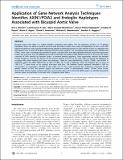| dc.contributor.author | Wooten, Eric C. | |
| dc.contributor.author | Iyer, Lakshmanan K. | |
| dc.contributor.author | Montefusco, Maria Claudia | |
| dc.contributor.author | Hedgepeth, Alyson Kelley | |
| dc.contributor.author | Payne, Douglas D. | |
| dc.contributor.author | Kapur, Navin K. | |
| dc.contributor.author | Mendelsohn, Michael E. | |
| dc.contributor.author | Huggins, Gordon S. | |
| dc.contributor.author | Housman, David E | |
| dc.date.accessioned | 2010-05-13T17:58:34Z | |
| dc.date.available | 2010-05-13T17:58:34Z | |
| dc.date.issued | 2010-01 | |
| dc.date.submitted | 2009-10 | |
| dc.identifier.uri | http://hdl.handle.net/1721.1/54784 | |
| dc.description.abstract | Bicuspid Aortic Valve (BAV) is a highly heritable congenital heart defect. The low frequency of BAV (1% of general population) limits our ability to perform genome-wide association studies. We present the application of four a priori SNP selection techniques, reducing the multiple-testing penalty by restricting analysis to SNPs relevant to BAV in a genome-wide SNP dataset from a cohort of 68 BAV probands and 830 control subjects. Two knowledge-based approaches, CANDID and STRING, were used to systematically identify BAV genes, and their SNPs, from the published literature, microarray expression studies and a genome scan. We additionally tested Functionally Interpolating SNPs (fitSNPs) present on the array; the fourth consisted of SNPs selected by Random Forests, a machine learning approach. These approaches reduced the multiple testing penalty by lowering the fraction of the genome probed to 0.19% of the total, while increasing the likelihood of studying SNPs within relevant BAV genes and pathways. Three loci were identified by CANDID, STRING, and fitSNPS. A haplotype within the AXIN1-PDIA2 locus (p-value of 2.926×10[superscript −06]) and a haplotype within the Endoglin gene (p-value of 5.881×10[superscript −04]) were found to be strongly associated with BAV. The Random Forests approach identified a SNP on chromosome 3 in association with BAV (p-value 5.061×10[superscript −06]). The results presented here support an important role for genetic variants in BAV and provide support for additional studies in well-powered cohorts. Further, these studies demonstrate that leveraging existing expression and genomic data in the context of GWAS studies can identify biologically relevant genes and pathways associated with a congenital heart defect. | en |
| dc.language.iso | en_US | |
| dc.publisher | Public Library of Science | en |
| dc.relation.isversionof | http://dx.doi.org/10.1371/journal.pone.0008830 | en |
| dc.rights | Article is made available in accordance with the publisher's policy and may be subject to US copyright law. Please refer to the publisher's site for terms of use. | en |
| dc.source | PLoS | en |
| dc.title | Application of Gene Network Analysis Techniques Identifies AXIN1/PDIA2 and Endoglin Haplotypes Associated with Bicuspid Aortic Valve | en |
| dc.type | Article | en |
| dc.identifier.citation | Wooten EC, Iyer LK, Montefusco MC, Hedgepeth AK, Payne DD, et al. (2010) Application of Gene Network Analysis Techniques Identifies AXIN1/PDIA2 and Endoglin Haplotypes Associated with Bicuspid Aortic Valve. PLoS ONE 5(1): e8830. doi:10.1371/journal.pone.0008830 | en |
| dc.contributor.department | Massachusetts Institute of Technology. Department of Biology | en_US |
| dc.contributor.approver | Housman, David E. | |
| dc.contributor.mitauthor | Housman, David E. | |
| dc.relation.journal | PLoS ONE | en |
| dc.eprint.version | Final published version | en |
| dc.type.uri | http://purl.org/eprint/type/JournalArticle | en |
| eprint.status | http://purl.org/eprint/status/PeerReviewed | en |
| dspace.orderedauthors | Wooten, Eric C.; Iyer, Lakshmanan K.; Montefusco, Maria Claudia; Hedgepeth, Alyson Kelley; Payne, Douglas D.; Kapur, Navin K.; Housman, David E.; Mendelsohn, Michael E.; Huggins, Gordon S. | en |
| dc.identifier.orcid | https://orcid.org/0000-0001-5016-0756 | |
| mit.license | PUBLISHER_POLICY | en |
| mit.metadata.status | Complete | |
